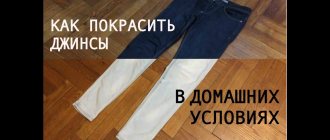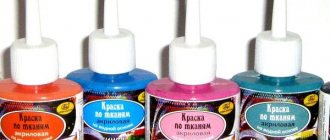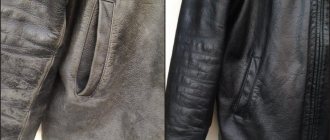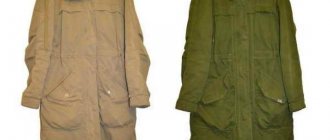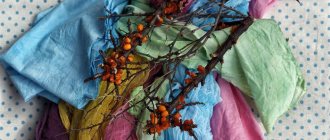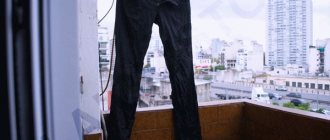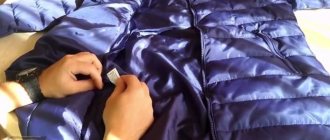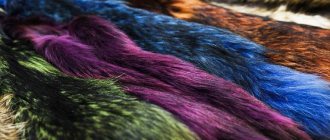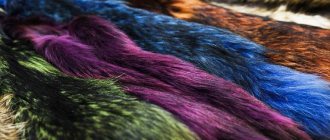- Hair dye
They do a lot of things to jeans to give them a fashionable look - tinder, boil them, tear them, decorate them with rhinestones and appliqués. “Distressed” denim has been popular for a long time. But lovers of conservative plain trousers, on the contrary, prefer to dye their jeans if they have begun to fray and lose their color uniformity.
The color on jeans fades due to prolonged wear, gets washed out when trying to remove difficult stains, and fades.
If you decide to dye your jeans, you don’t have to take them to the dry cleaner - you can restore the color of the fabric yourself at home. Both special dyes and a variety of improvised means are suitable for coloring.
It is easier to achieve high-quality uniform dyeing of fabric when the selected paint matches the original color or is darker than it. That is, any jeans can be easily dyed black, but turning black trousers, for example, into blue is unlikely.
How to dye jeans
It happens that your favorite item loses color during wear. Paints may be washed out by detergents during washing. To restore the shade and give a second life to jeans, there are several proven dyeing methods:
- Blue. The product helps to refresh the color of the fabric. The substance creates a short-term effect, so the event will have to be repeated periodically.
- Potassium permanganate. Used to achieve the “jeans-jeans” effect.
- Hair dye. Depending on the size of the product, you may need 1 or 2 packages.
- Felt-tip pens. You can use old felt-tip pens that don't write, but still have ink in them.
- Dry dyes for textiles with powder structure. Can be purchased at textile stores or points of sale of household chemicals and household goods.
- Acrylic paints for fabric. They contain thermal resins, so they are securely fixed after ironing. The product gives the fabric additional density. This fact must be taken into account.
- Aniline dyes for textiles. They come in liquid and powder form. The paints are easy to use. They do not stand out for their high durability.
- Stamp inks. Used for marking textiles. Withstands many washing cycles.
- Using the above compositions, you can not only restore the brightness of faded clothing, but also create an individual style using painting. Bored jeans or a jacket can be repainted in a radically new shade. For example, from white to black.
Possible problems and errors
- If powder paints are poorly diluted, the color of things will be uneven and stains will form on them.
- If you choose the wrong time for painting or washing temperature, the paint will quickly wash off.
- If stains are not removed from clothing or dirt is not washed off first, these areas will be more noticeable after dyeing and will take on a different color.
- The dye is added only to the washing machine drum; it cannot be mixed with powder, conditioner and other detergents.
- With an expired dye or a preparation whose characteristics do not suit the type of fabric, the result will be unpredictable.
Advantages and disadvantages of various methods
So, we list the advantages and disadvantages of some painting methods:
- Potassium permanganate. This method will require some skill on your part. It would be a stretch to call it simple. But as a result, you can achieve the effect of washed jeans that never go out of style.
- Blue. It is the most affordable budget coloring product. The advantages include ease of use, but the disadvantages include low color stability to the external environment. It washes out with every wash and requires constant renewal of intensity.
- Aniline based paints. The instructions on the packaging describe the entire process in detail. The main thing is to strictly follow the application plan. Unique is the ability to mix different shades of the product to obtain fundamentally new colors.
- Acrylic paints. They have increased durability. As soon as they dry, they immediately stop responding to external influences until boiled or washed with powder.
- Dyes in powder. You can easily and simply use powder options when running things through an automatic machine. This process is the least troublesome, but you don’t have to expect rainbow shades.
Where can you dye clothes?
You can restore faded or faded dye on textiles at home or at a dry cleaner. Coloring things will help restore the previous shade or create a new one. If your white jeans have faded to a yellowish or gray color, they can be dyed or bleached.
You can dye textiles at home by hand or in a washing machine. Both of these methods are effective and extremely simple. Using the recommendations, you will cope with the task without much effort.
Manual painting method
To work with textiles you will need:
- Dye;
- Household scales;
- Salt;
- Vinegar in an amount of 30 ml;
- Large metal container.
- The dyeing method depends on the dye that will be used. Using a scale, you need to determine the weight of the clothing in order to accurately calculate the proportion of the dye. The intensity of coloring and color fastness will depend on this.
- Vinegar and salt are used to fix the paint. These substances are dissolved in water and textiles are rinsed in them. The last rinse is carried out in cool water without additives.
Changing the color of clothes in the washing machine
- Many people are familiar with the situation when one colored sock can turn a dozen white things into a different color. An absurd problem was inspired by the method of household dyeing of clothes.
- The whole process can be divided into several stages:
- Prepare the product for painting. This could be pants or a jacket. It is important to pre-wash, remove stains if possible and remove decorative elements.
- Measure the weight of the clothes.
- Prepare the dye according to the instructions.
- Strain the prepared solution through cheesecloth or a fine sieve and pour into the drum or compartment for washing powder.
- Place clothes in the washing machine compartment. It is better to load items immediately after pre-washing. Damp fabric is easier to dye.
- Set the boiling program to 95 degrees.
- Set the timer for at least 30 minutes.
- At the end of the wash cycle, add salt to the drum and rinse. The amount of salt should correspond to the proportion: 1 cup per 1 kg of fabric.
- You can repeat the vinegar rinse and do a short wash without additives to lock in the dye and wash out any remaining dye that didn't take.
- Remaining pigment can be removed from the drum by dry washing with liquid bleach. The rubber seal should be wiped with a clean cloth.
Features of denim dyeing
The most common jeans in stores are all shades of blue, light blue and gray. Grays and blacks fade the most over time. Dark blue colors are long lasting.
It should be borne in mind that even after several dyeing procedures, denim is unlikely to become perfectly black, as in the store. Even with professional products you will get a dark gray color.
Preparing tissue for the procedure
To ensure that the paint goes on as evenly as possible, you need to prepare the denim for dyeing:
- Wash the product thoroughly. Set the water temperature to 40°C - this is the optimal value for denim. Wash as usual - with powder and conditioner. After washing, do not dry the jeans - dyeing is done on damp fabric. For light blue and light blue jeans, this step is sufficient. Further actions are carried out on products of bright or dark colors: red, burgundy, purple, dark blue and the like.
Washing is necessary to remove substances from the fabric that may interfere with the coloring or make it uneven. - Fill a large saucepan with water. The size of the pan should be large enough to wash jeans in it. Add bleach to water. Ordinary chlorine may also work, but it is better to use more gentle products, for example, Belize. It is added to water in a ratio of 1:10. Washing should be done in a well-ventilated area, as chlorine vapors are hazardous to health.
White is a good way to bleach jeans. - Place a saucepan of water over high heat.
The size of the pan should allow the product to be completely soaked in it. - When the water is ready to boil, reduce the heat to low and place the jeans in the pan. While stirring the product with a long wooden spoon or spatula, soak it in hot water until it lightens by 2-3 shades. Some jeans may change color to beige or yellowish - this is normal. Discoloration will take 30 to 60 minutes.
A wooden spoon with a long handle is convenient for stirring jeans in a large saucepan - the wood does not heat up from the steam - Turn off the heat and drain the bleach solution from the pan. Rinse your jeans thoroughly.
To remove bleach from jeans, rinse them in running water. - Wash the jeans again in the washing machine using detergent. This will remove any remaining bleach that could interfere with the paint job or damage the fabric. Do not dry the product before painting.
Dyeing clothes at a dry cleaner
If you want to restore the color of something dear to you or are not sure that you can cope with the task yourself, you can always turn to the services of professionals. This option has a number of advantages:
- Masters guarantee high-quality results.
- You can perform detailed color restoration in individual areas.
- Specialists will be able to radically change the color of the product and create a new shade.
- The salon has a wide selection of paints.
- Experienced craftsmen are familiar with the nuances of the textile industry, as well as the variety and properties of dyes. They have high-tech equipment and use advanced techniques. You will be warned about possible risks and the specifics of the work will be agreed upon.
- In addition, there are advantages in that you do not need to waste your time and effort working with the material. There is also no need to wash the surfaces of household items from the dye. Also in this case there will be no problems with finding a dye and selecting a shade.
What fabric can be dyed
Fabrics made from natural fibers can be dyed well. This works especially effectively with linen, cotton and their mixtures. Silk and wool require special formulations, since these materials do not like high heat.
Using the same dyes as “pure” natural fibers, we update the color of mixed fabrics. These are those in which synthetics are 40% or less. But each composition has its own permissible level of the presence of synthetic additives, so read the instructions carefully.
How to dye clothes - depends on the type of fabric
From synthetics, acrylic and viscose are dyed well. For them you can use the same dyes as for natural fabrics. Pure polyester and nylon are almost impossible to dye at home. So far there are only a few paints that can cope with this task. We'll talk about them below.
Before you dye your clothes, pay attention to the threads used to make the seams. If they are synthetic, they may remain the “old” color. This must be taken into account when choosing a color or degree of coloring.
Dye for jeans
Dyes that can be purchased to change or restore the shade of jeans can be divided according to the following parameters:
- composition;
- structure;
- packaging;
- origin;
- purpose.
- The composition of textile dyes is varied. The components contained in the substance affect its durability and brightness. Some elements are capable of changing or transforming the structure of the fabric to which they are applied. For example, acrylic gives the canvas additional strength and density.
- The structure or form of release of the dye is responsible for the method of its application. There are three main types:
- powder;
- liquid;
- aerosol;
- pasty suspension;
- natural look.
- The packaging of the paint ensures shelf life and ease of application. It can be paper, polyethylene, in the form of a tube, balloon or jar.
- By nature, dyes can be divided into two main groups:
- Natural. An environmentally friendly method of dyeing textiles using plant and food ingredients. They are often used in their natural form, as well as in the form of juices and decoctions.
- Synthetic. Elements obtained by chemical means. They are often extracted during the technological processing of various substances using the production method.
- Depending on the purpose, the paint can be applied with a brush to local areas or evenly distributed over the entire surface of the canvas.
- The choice of dye depends on the goals and needs of the person.
Features of using acrylic products
How do you dye jeans if you want to end up with an original item that no one else will have an analogue? The ideal option is bright and durable acrylic paints that will not fade or fade. They are used for artistic painting - a good option to refresh an item or hide a stain. The use of this type of paint has seven features.
- Preparation. Before starting work, jeans are washed, completely dried and ironed. This will allow the paint to adhere better between the fibers.
- Ease of application. The area on which the drawing will be applied must be placed on a flat surface and secured (for example, with paper clips or double-sided tape).
- Draw the outline. This can be done using a soft pencil or carbon paper.
- Amount of paint. The acrylic layer should be as thin as possible. Otherwise, it may start to peel off.
- The right brushes. To apply a clear pattern, which implies a dense overlap, soft bristles are suitable. For translucent patterns, it is better to use hard brushes.
- Drying. Acrylic paint sets instantly. But it will take at least 15 hours for it to dry completely.
- Recording the result. To ensure that the paint sticks firmly to the jeans, iron the product from the wrong side or through a sheet of paper.
Despite the fact that acrylic is highly resistant, it is not recommended to expose items painted with such paint to high temperatures. Machine washing and strong rubbing should also be avoided.
Blue for jeans
The simple and affordable composition is ideal for restoring the color of classic denim items. The drug is available for purchase in hardware stores. Please read the instructions carefully before use.
Please note that the substance is suitable for tinting blue items. It will not be possible to completely change the shade with this help. The durability of the bluing is not high, so after a while you will have to repeat the procedure.
Another point that cannot be neglected is that during the washing process after dyeing, the pigments from the fabric will be washed out, so it is better to wash the item separately from others or with clothes of the same color.
In what cases may it be necessary to dye jeans?
Clothes, unfortunately, wear out over time and lose shape and color. Despite its strength, denim material can wear out and its shade can fade. To give your jeans a fresher look, you can dye them. Black paint will also help hide stubborn stains.
Dyeing denim will also help if you don’t like the color of the purchased item over time. With the help of home dyeing, you can give your jeans fashionable shades and patterns: “varenka”, stains, patterns.
Repainting old things will also allow you to always be in trend and follow fashion trends without unnecessary expenses. Or maybe you've decided to completely update your wardrobe, and the color of your jeans doesn't match your new clothes. In order not to spend money on buying new trousers, it is easier to repaint them.
How to dye jeans blue
To dye denim trousers, you need to follow the following sequence of steps:
- dilute the blue in water whose temperature is not lower than 30 degrees. Adjust the concentration of the solution depending on the desired result. To increase color fastness, you need to add a concentrate of 2 tablespoons of salt.
- Place the jeans in a bowl with the solution.
- For thorough dyeing, leave the pants in the solution for 2 hours. Turn the pants over periodically to ensure an even finish.
- Use a weak vinegar solution as a color fixer.
- Rinse the item thoroughly in cool water.
After drying, it is recommended to iron the clothes and can be worn.
Professional dyeing of clothes and fabrics
Some dry cleaners offer textile dyeing services, in particular denim. The cost of such a service depends on the city, the size and weight of the product, as well as the materials used by specialists. As a rule, the price of dyeing size M jeans is about 700–1000 rubles.
The advantages of this service include a guarantee of good results. Specialists with experience have a better chance of performing high-quality, uniform dyeing of fabric. The disadvantages, in addition to the price, include the need to part with the product for a week, or even more.
How to dye jeans with hair dye
If you can't find a special textile dye, try dyeing your jeans with hair dye. This method is especially good for black fabric. You can choose a shade from the following options:
- black;
- deep black;
- blue-black;
- black sapphire.
- It’s good if the composition does not contain ammonia. The coloring process is extremely simple:
- Prepare your jeans by removing any decorative embellishments.
- Dissolve the dye in warm water. Mix thoroughly.
- Place the pants or jacket in the bowl of solution.
- Leave for 60 minutes.
- Remove from solution.
- Rinse with salt and vinegar.
- Rinse one last time in cool, clean water.
- After dyeing is completed, dry the clothes and iron them. The item is ready to wear.
Ways to use powder dyes
Jeans dyeing includes both machine dyeing and manual color changing. Let's look at the options in more detail.
Machine dyeing
- To ensure that your pants do not become spotty, but acquire a uniform, even tone, first dissolve the dye as indicated on the label. If there is no information, then dilute the standard sachet in 0.5 liters of water. During the process, make sure that all the powder is dissolved, because lumps and grains of sand can ruin the job.
- Place the prepared solution in the drum of the washing machine. If the label on your item says that you should add salt or soda, then add the same ingredients to the drum.
- Load the item you are going to revive into the machine. For cotton or linen, set the temperature to 95 degrees.
- As for time, it is better to choose the longest period. After the machine finishes working, take out the pants and place them in the basin. First, place vinegar diluted with water in a basin at the rate of 1 tbsp. vinegar per 1 liter. liquids.
- Let the trousers soak in this solution for 25 minutes. After that, wash them in the machine in the usual way for jeans: a minimum period of time, and a temperature of no more than 40 degrees.
- Upon completion of all manipulations, your trousers will acquire the desired shade.
Dyeing in an enamel vessel
- Dilute the coloring powder in a liter of hot water. Carefully review the packaging; if it indicates that you need to add soda or salt to the composition, then add the required amount. Stir until completely dissolved.
- Pour the resulting solution into an enamel container. Add 5-7 liters of water there. Place the pants you want to dye in this bowl.
- Move the basin to the fire and “cook” them at a temperature of about 95 degrees for about 60 minutes. Systematically stir the contents of the basin with tongs or a stick.
- As soon as the “cooking” period is over, remove the trousers from the solution, cool, and rinse them first in warm water and then in cold water.
- Soak clean pants for half an hour in a vinegar solution, and then wash them by hand using washing powder.
Now you know how to dye old jeans to refresh your favorite item and get a fashionable new addition to your wardrobe.
Important! If you have used a washing machine, do not wash white items in it immediately after the dyeing procedure. It is better to let the equipment run idle for a session to whiten the drum a little.
How to dye a denim jacket
To freshen up a jacket or change its tone, you need to follow certain rules. Otherwise, the result may not be exactly what you expect. Here are the main recommendations:
- You need to remove all removable parts: hood, collar, fur or cuffs.
- Carefully remove the buttons;
- Check pockets and empty them;
- Fasten the zippers.
- If necessary, wash the jacket and remove stains.
- Next, color according to the instructions for the type of dye you are using.
- Calculate the components taking into account the weight of the product.
- After dyeing, rinse with salt and vinegar.
- Do not spin. If necessary, remove excess moisture with a dry cloth.
After drying, sew the buttons back and return the additional elements to their original places.
How not to spoil something
When dyeing at home, it is important not to spoil your favorite item. You need to do everything possible to make it look like new.
To maintain the appearance of your trousers, you need to:
- follow the instructions indicated on the dye packaging;
- do not add large amounts of chlorine for bleaching: it can damage the fabric structure;
- properly prepare the canvas for painting so that the pigment lies evenly;
- after dyeing, the jeans are rinsed in water with the addition of 1-2 tbsp. l. vinegar (acid helps fix the dye to the fabric);
- For the procedure, it is best to use purchased professional dyes rather than improvised means - this way the effect will be more predictable;
- If you have an old thing that you don’t wear when going out, you can practice on it.
When jeans are dyed with herbal substances or improvised means, it is important to carefully follow all recommendations.
How to dye cotton trousers
If your favorite cotton pants have faded and lost their attractiveness, you can restore them to their former beauty using aniline dye or any dye that can be used for this type of fabric.
Let's take a closer look at what actions need to be performed:
- Decide on the shade and type of dye.
- Prepare the product for use. Remove buckles, buttons and decorative hardware. Empty your pockets. Pre-clean the fabric.
- Moisten the material to improve the dyeing result.
- Paint the item according to the dye manufacturer's instructions.
- Record the result using saline and vinegar solutions.
- Rinse thoroughly in clean water.
If necessary, repeat the procedure periodically so that the color of the textile product is always bright.
Method - pour the solution into the washing machine
Straighten your jeans and turn them inside out. Don't forget to empty your pockets!
- It is better to use a temperature setting for washing of 90-95 degrees, duration - 1.5 or 2 hours.
- Prepare a fixing solution: 1 tbsp. add a spoonful of 9% vinegar to 1 liter of water.
- After washing, place the jeans in the fixing solution for 20-30 minutes.
- Then wash the product in a machine at 40 degrees. WARNING: Do not use conditioner as this will damage the color of the jeans.
- Then run the machine idle to get rid of any remaining ink in the drum.
How to color pants with felt-tip pens
If you have used markers with ink left over, use them to color your pants. The method is especially effective for highlighting material. How to do it:
- Remove the rods from the housing and place them in a container of water.
- Wait a while.
- When the water turns black, place your pants in it, after removing the rods.
- Soak the clothes in the solution for at least an hour.
- Turn the fabric over periodically.
- Rinse in vinegar and salt concentrate and then in clean water.
This simple and non-standard method will help restore the former color of your favorite clothes.
Painting with stripes
Stripes on jeans can be applied manually with an aerosol with a stencil or a brush. Different methods are used:
- you can create fuzzy, blurry boundaries of color transitions with aniline;
- to fix the dye, tragacanth glue is added to the aniline in a ratio of 1:3, or the jeans can be pre-soaked in gelatin;
- Any drawing is created with acrylic-based paints. They are applied to a dry item along pre-drawn contours. The paint dries for 10-15 hours, and then the jeans are smoothed with an iron.
Washing is allowed only by hand without aggressive household chemicals.
Some useful tips:
- Take care in advance to protect the work area from dye ingress. Cover the surface with a protective layer of polyethylene or thick paper.
- Use gloves to protect your hands.
- If you cannot remove stains from clothes, you need to choose dark colors for dyeing.
- To prepare the fixing composition, use 30 ml of vinegar per 3 liters of water.
- When using the manual cleaning method, it is important to thoroughly mix the clothes in water to ensure an even color.
- Consider the original color of the fabric. To change the shade dramatically, pre-bleaching may be required.
Having studied the options for using textile dyes and the range, you can easily return the color of a worn item or create an exclusive option for your wardrobe. You can experiment with dye components and come up with your own options. As a last resort, you can always contact a dry cleaner to rectify the situation and receive qualified assistance from specialists.
Preparing jeans for dyeing: general rules
Before dyeing your trousers, prepare everything you need:
- black dye for denim;
- gloves;
- salt, vinegar;
- container (stainless steel or enameled) with a capacity of at least 8-10 liters;
- wooden clothes tongs;
- a piece of old clean cloth (approximately 30x30 cm).
Before dyeing, treat stains and then proceed to washing.
Alternative solutions
If you like experiments, buying a dye and then applying it according to the instructions is too banal and boring. A number of alternative products will help you achieve the desired color and original effects.
Chlorine bleach
Peculiarities. “Varenki” are legendary jeans. More than one generation of fashionistas has strived to own this thing. The technology came to us from Japan. There, nodular staining has been elevated to the level of an art. If you want to show off in jeans with beautiful white streaks, you will have to work a little magic on the item.
Treatment
- Fill a metal bucket with water and add a cup of chlorine bleach.
- Crumple the jeans into a ball or twist them and tie them tightly with string to secure the shape.
- Immerse the item in the liquid and place the bucket on the burner.
- Boil the jeans over medium heat for a quarter of an hour.
- Rinse the product thoroughly in cold water.
If you're not sure how to properly dye old jeans that are faded, try bleaching them completely for a stylish new look. The technology is the same as for making “varenok”, but there is no need to twist or tie the product.
Potassium permangantsovka
Peculiarities. Potassium permanganate is another means with which you can make fashionable “varenki”. This is a great way to partially dye jeans by hand without boiling or any other heat treatment.
Treatment
- Mix a heaping tablespoon of manganese with half a glass of vinegar and two tablespoons of peroxide.
- Dilute the resulting composition with water (3 l).
- Roll the jeans tightly and secure them with ropes or elastic bands.
- Place the product in the solution for 20 minutes.
- Rinse your jeans several times in cold water and wash them with powder.
Zelenka
Peculiarities. If you want to dye your jeans green, the ideal solution is brilliant green. With some simple manipulations you can turn it into an excellent dye for clothes.
Treatment
- If you want to dye your white jeans, just wash and iron them. If the product is of a different color, it must first be kept white.
- Dissolve the contents of a standard bottle of brilliant green in 5 liters of water.
- Soak wet jeans in the solution for half an hour.
- Rinse the product in cold water and soak in water and vinegar for a quarter of an hour.
Hair dye
Peculiarities. Hair dye is one of the alternative means for dyeing jeans. It gives the fabric a rich shade and holds up well. As a rule, it is used to dye thick regular or corduroy jeans.
Treatment
- Pour warm water into a basin or bucket and add paint of the chosen shade. If you use toner, you will need two bottles for the brightness of the color.
- Immerse washed and dried jeans completely in the solution for one and a half to two hours.
- To remove any remaining dye, rinse the item several times. Alternate warm and cold water.
- Pour water into the container. For each liter, add two tablespoons of vinegar and one spoon of salt. Leave the item in the composition for 15 minutes.
- Wash the product in powder and hang it to dry away from sunlight and heating devices.
If you want to refresh the black color of your jeans, use basma. This is a natural dye that will not harm either the skin or the fabric.
Vegetables, berries, herbs
Peculiarities. You can dye light jeans at home using food products. Natural dyes of all colors of the rainbow from the table will help you experiment with style. The process includes four stages.
Treatment
- Squeeze juice from berries or vegetables and dilute it with hot water. Pour boiling water over dry herbs or spices and let steep until cool. The proportions of dye and water are determined by eye. The more pigment, the brighter the color will be.
- Place the product in the container with the solution. The liquid should completely cover it.
- For three to five hours, constantly turn the item over to distribute the dye evenly.
- Rinse the product in water acidified with vinegar or a weak saline solution.
Table - Natural dyes for jeans
| Desired shade | Natural dye |
| Orange color | - Carrot; - onion peel |
| Yellow | - Bay leaf; - dried calendula flowers; - turmeric |
| Brown color | — Oak bark; - nut shell; - Black tea |
| Green color | - Sorrel root; - spinach |
| Pink color | - Cherry; - raspberries |
| Grey colour | — Blackberry |
| Blue | — Red cabbage |
| Blue color | - Cauliflower; - dry cornflower petals; - blueberry; - dark grapes |
| Red color | - Pomegranate; - beet |
The highest color intensity is observed after staining with berry juices. Vegetables and dry dyes have much paler pigments.

